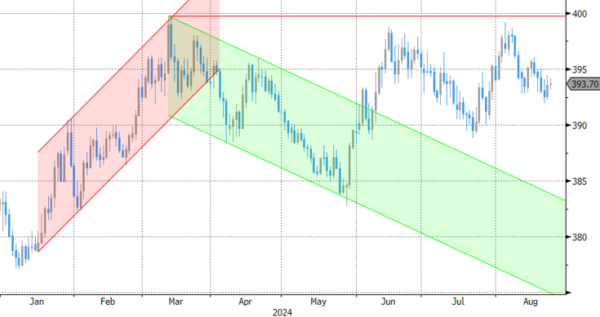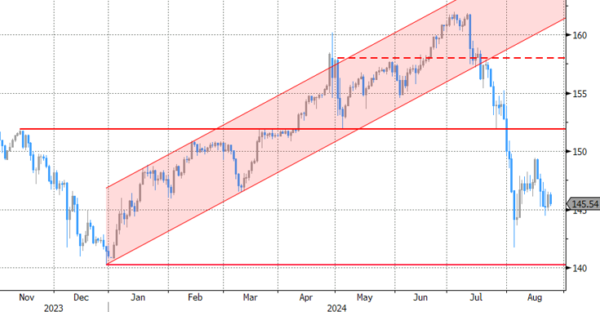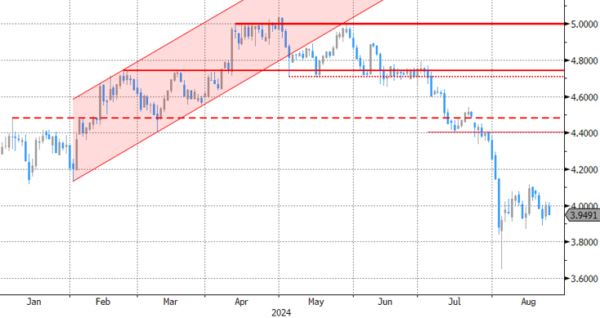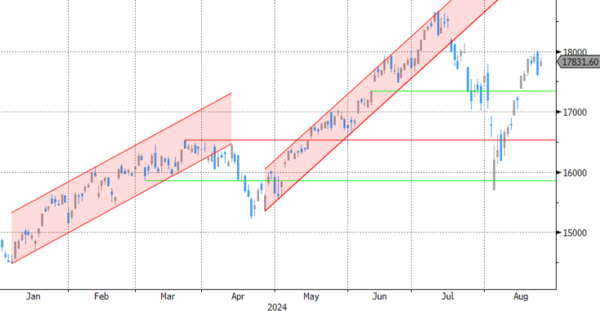Markets
At a hearing before Parliament this morning, BoJ governor Ueda had a balanced but after all clear message. The BoJ has started policy normalization and intends to further walk that path if inflation and growth continue to develop in line with the banks’ expectations. The market volatility in the wake of the July decision didn’t change the BoJ’s basic intention to bring its policy rate to a more neutral level. It will assess the impact of this volatility on inflation and activity. Still the basic assumption is that market swings might cause caution on the timing of a next move, but that it won’t change the new direction of policy. Anyway, the BoJ governor also downplayed the BoJ rate hike as the trigger for the market meltdown early August. He pinpointed US recession fears as an important factor for the sharp market repositioning. A next hike in September is unlikely, but gradual further normalization in Q4 (December) looks very reasonable. With the Fed starting a protracted easing cycle next month, the yen now looks much better protected than was the case two months ago. USD/JPY today is ceding modest ground (146) going into Fed Chair Powell’s lecture at the Jackson Hole Symposium.
Recently, softer US growth and inflation data caused markets to discount quite a sharp reduction of Fed policy tightening this year (minus 1% this year and almost 1.25% additional reduction next year). This brought in particular US long term yields back close to important support levels (10-y 3.80% area, 30-y 3.93%/4.0% area). The 2-y yield tentatively shifted to a wait-and-see approach near the 4.0% barrier. Key question for markets was whether Powell would ‘validate’ (or at least not reject) current market pricing or whether he would advocate a (much) more gradual approach.
First headlines from the Fed Chair’s speech are seen as tilting to the dovish side. Powell indicates that confidence has grown that inflation is on a path to 2% and the cooling of the labour market is ‘unmistakable’. The labour market is unlikely to become a source of inflation soon and the Fed doesn’t seek a further cooling of the labour market. At the same time Powell sees the current level of the policy rate as giving ample room to respond to risks. The timing and pace of cuts still depend on the data and the outlook, however markets clearly see this as the Fed further turning away the focus from inflation to supporting the labour market. After trading little changed going into Powell’s address, markets see this tone as keeping the door open for 25+ bps rate cut steps at some point in a not that distant future. US yields decline between 8 bps (2-y) and 4.5 bps (30-y). The dollar resumes its decline (EUR/USD 1.1165, DXY 101.2, USD/JPY 145.2). Equites rally, rising up to 1.75% (Nasdaq).
News & Views
The Czech Ministry of Finance lowered its GDP forecast for this year to 1.1%. Minister of Finance Stanjura said that a data revision by the Czech Statistical Office is the main reason for lowering the estimate. The base for 2023 was higher than expected as last year’s drop in the economy was not 0.3%, but only 0.1%. The MoF now expects the economy to accelerate to 2.7% GDP growth in 2025. Household consumption and government spending are the main drivers. Czech inflation is set to oscillate around the CNB’s 2% inflation this year (2.4% average) and in 2025 (2.3%). Real wages are expected to increase by 4% and the unemployment rate should stay near its record low. The Czech krone treads water today near this month’s recovery top around EUR/CZK 25.05.
Hungarian PM Orban’s cabinet chief, Rogan, said that the central bank is right to proceed cautiously in its interest rate cuts. The comments came after economy minister Nagy earlier this week made renewed calls on the central bank to support growth, referring to the MNB as a cyclops with an eye set only on inflation. Rogan said that politicians would always tend to urge faster moves but the central bank is right to take its own independent decisions. We think that the MNB will next week keep its base rate on hold at 6.75% and only conduct a next 25 bps rate cut in September, after the ECB and the Fed probably did the same. Upward (core) CPI surprises in July and more fragile forint (EUR/HUF 394) call for caution. Our end-of-year forecasts is unchanged at 6.25%.
Graphs
EUR/HUF: forint hovers near 393 as MNB might take a pause in its easing cycle next week.
USD/JPY: dollar resumes decline on ‘soft’ Powell adress.
US 2y yield: drifting further below 4% mark.
Nasdaq extends rebound as Powell suggested further easing of financial conditions.
















